Abstract
Oil production is a complex technological process. For this, many complex installations are used, with a different principle of operation. When learning how to work with them, the equipment itself is not always available. Therefore, one of the solutions to this problem is the use of a specialized software package. The proposed work describes a software system for training oil production units using modern virtual reality technology. During its creation, realistic graphical 3D models of an oil pumping unit, an oil drilling rig, a crawler mobile drilling rig and a mobile drilling rig based on a car were developed. These models were animated using the Blendler software. This makes it possible to enhance the visibility of the principles of operation of oil-producing installations. For a more significant visual effect, these models were placed in a specialized Unity software environment running the Android operating system, supplemented with theoretical material and formed pictures of virtual reality.
Keywords: Learning systems, oil refineries, virtual reality
Introduction
Oil production and oil refining are complex technological processes. Researchers Fyk and Khripko (2015) note they require a lot of specialized equipment. It is quite difficult to use, and when studying in an educational organization, there is not always physical access to the equipment, as it is expensive.
A description of the setups can be found in Krets and Shadrina (2011). In particular, oil production requires the use of drilling rigs. A drilling rig is a set of surface equipment required to perform well drilling operations. The drilling rig consists of drilling derrick, substructure, tripping equipment, main engine, mud pump, blowout prevention equipment.
A drilling rig is a high and durable structure above a well for lowering and raising downhole motors, drill pipes, drilling tools, placing drill stands after they are pulled out of the well and protecting the working crew from precipitation and wind. The main parameters of the tower are the carrying capacity, weight, height, dimensions of the upper and lower bases, the length of the stand, and the storage capacity for the drill pipe stands.
Mobile drilling rigs can be used to perform drilling operations in densely built-up areas or in areas with difficult terrain.
Training in the basics of the operation of various oil production units mentioned above is possible using a specialized software tool using virtual reality technology.
Virtual reality (virtual reality) is a complex technology that allows you to generate, using computer software and hardware, a three-dimensional digital environment transmitted to a person through his sensations and representing a semblance of the surrounding real world, which imitates the impact or reactions to the user's impact by projecting the created effects onto him. consciousness with full immersion for maximum approximation to reality.
The use of virtual reality is described in articles by Onyesolu and Eze (2011), Rakhmatullaev et al. (2021), Schleußinger (2021), Smolin et al. (2018).
Virtual reality has a variety of properties:
- plausibility is how realistic virtual reality looks;
- interactivity - this criterion reflects the possibility of interaction with objects;
- machine-generated criterion - based on hardware, which guarantees constant performance;
- an accessible part for study - to provide an opportunity to explore a large and detailed world;
- the created effect of presence - the involvement of the user in the gameplay through his senses.
This allows you to widely use the possibilities of virtual reality in the learning process.
Problem Statement
As mentioned above, there are many technical devices for oil refining and oil production. The study of their work is associated with the following problems:
- The complexity of the operation of installations consisting of many parts.
- Lack of physical access to equipment in the educational organization.
- A large number of equipment with different operating principles.
At the same time, understanding the operation of the equipment is impossible in the absence of the equipment itself. And the presence of an oil rig, for example, is a great difficulty in learning, since this is often unrealistic.
Research Questions
The proposed study addresses the issues of accessibility of training in the basics of oil production installations through visual study using modern virtual reality technology.
Purpose of the Study
The purpose of the work is to create a special software tool that allows you to visually demonstrate the operation of oil production units. This software is for teaching purposes.
Research Methods
In the course of the work, the following research methods were used:
- System analysis (to collect information on oil producing installations).
- Visual modelling (to create graphic 3D models of oil production units).
- Virtual reality technology.
Findings
As a result of the work performed, a specialized software tool was developed that allows teaching how to work with oil production units.
Since this software package is complex, an activity diagram was built to demonstrate how to work with it, which is shown in Figure 1. An activity diagram is a diagram that allows you to visualize a specific use case in more detail. This is a behavioural diagram that illustrates the flow of activity through a system. The principles of its creation are described in Dubakov and Silich (2005).
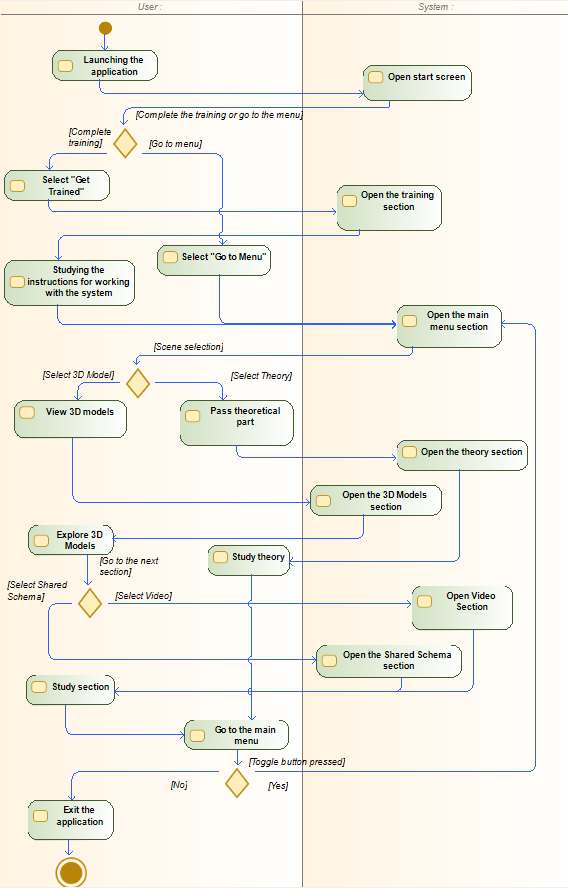
Blender was used to create 3D graphic objects. Based on real images of the installations, 4 different 3D models were created:
- oil pumping unit consists of 73,195 peaks;
- oil rig consists of 60,792 peaks;
- mobile crawler drilling rig consists of 57,576 peaks;
- the vehicle-based mobile drilling rig consists of 56,425 peaks.
An example of a 3D model is shown in Figure 2.
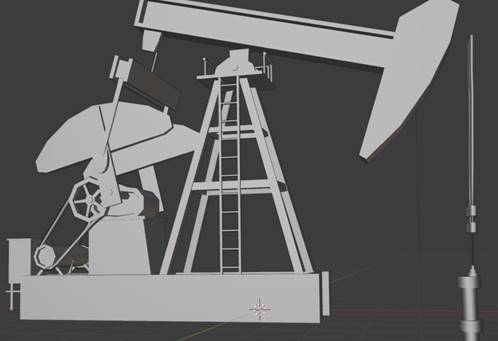
An animation was developed for each created 3D model using the software tool, demonstrating their work. Figure 3 shows an animation of a mobile drilling rig.
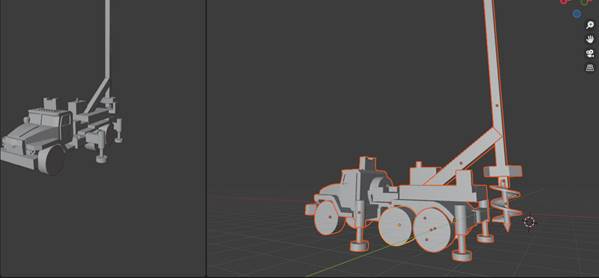
To create the effect of presence, virtual reality, the Unity project was developed to work with mobile devices on the Android platform. A description of working with Unity can be found in Istratova and Cherniy (2017), Pasko, (2016), Vinogradov and Cherkasov (2016). In the book Hawking (2016), Linoves (2016) you can find a description of the technology of working with the software package and examples of application.
Since virtual reality allows you to graphically represent information, a sequence of changing "pictures" - scenes - was developed. As a result of the development of the project, 21 scenes were created:
- 1 starting scene;
- 2 scenes teach the user how to work with virtual reality;
- 1 main menu scene;
- 4 scenes with 3D models;
- 4 scenes with general installation schemes;
- 2 scenes with video material;
- 7 scenes with theoretical material about oil.
Figure 4 shows the scene for selecting the type of oil production unit under study. An example of a scene view with a 3D model of a mobile drilling rig based on a car and information about it is shown in Figure 5.
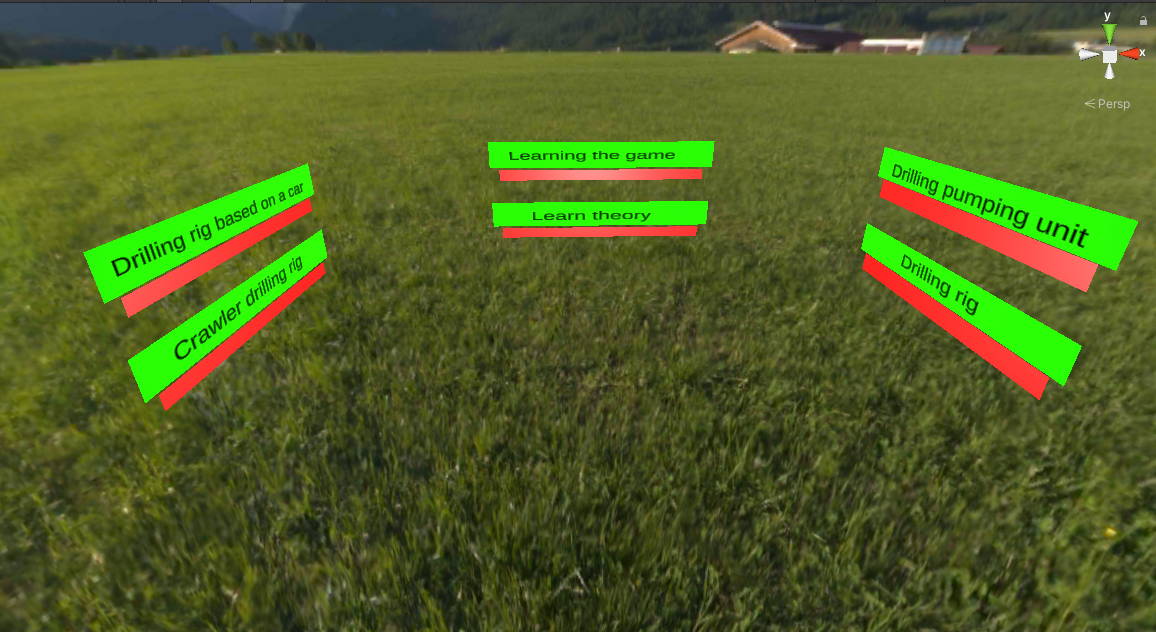
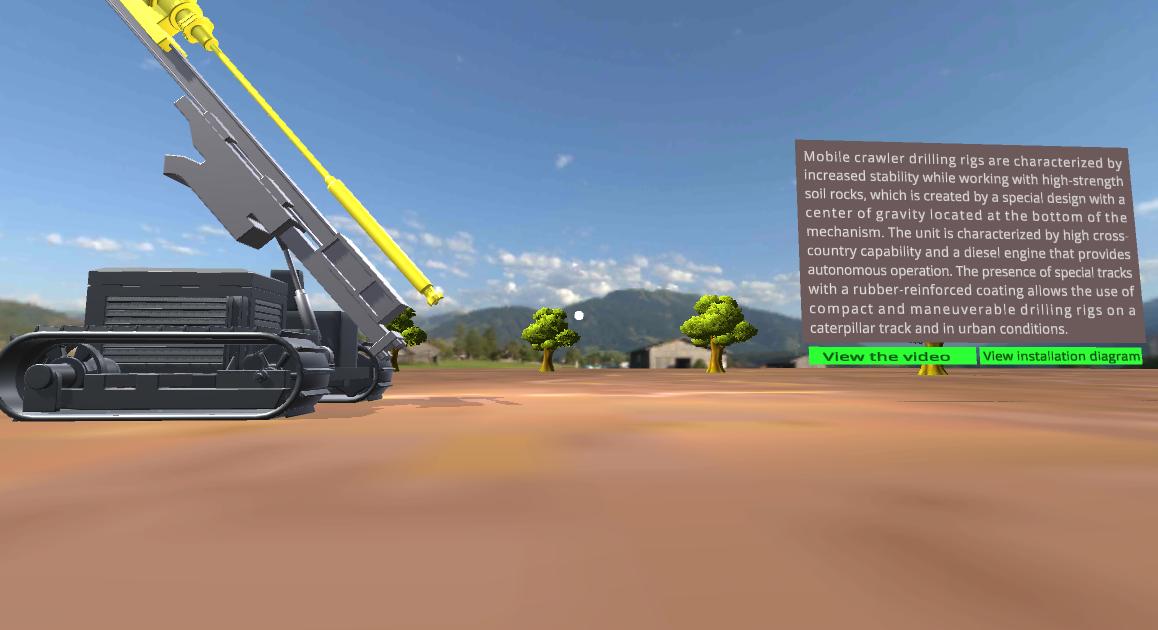
Conclusion
The main result of this work is the development of visual 3D models of oil production units. They allow you to visualize their structure. Each model is animated. This provides visibility when teaching the principles of operation of these installations.
As a result, a specialized software tool with virtual reality technologies has been created, which allows teaching the use of oil production units.
References
Dubakov, S. A., & Silich, V. A. (2005). Using a set of UML diagrams to build performance models. Bulletin of the Tomsk Polytechnic University. Georesource Engineering, 308(3), 154-158. https://www.lib.tpu.ru/fulltext/v/Bulletin_TPU/2005/v308/i3/37.pdf
Fyk, M. I., & Khripko, E. I. (2015). Fundamentals of development and operation of oil and gas fields: textbook. Folio. DOI:
Hawking, J. (2016). Unity in action. Multiplatform development in C#. Piter. https://www.amazon.com/Unity-Action-Multiplatform-Game-Development/dp/161729232X
Istratova, E. E., & Cherniy Yu. S. (2017). Comparative analysis of free software for 3d-modeling. Creativity and modernity, 1(2). https://nsktvs.ru/node/49
Krets, V. G., & Shadrina, A. V. (2010). Fundamentals of oil and gas business. Tutorial.Publishing House of the Tomsk Polytechnic University. https://www.studmed.ru/view/krec-vg-shadrina-av-osnovy-neftegazovogo-dela_bbe88d8235c.html
Linoves, Jonathan. (2016). Virtual reality in Unity. DMK Press. https://www.amazon.com/Unity-Virtual-Reality-Projects-immersive/dp/178398855X?asin=178398855X&revisionId=&format=4&depth=1
Onyesolu, Moses, & Eze, Udoka. (2011). Understanding Virtual Reality Technology: Advances and Applications. DOI: 10.5772/15529
Pasko, D. N. (2016). Modern game engines. Innovative science, 2-3, 127-130. https://cyberleninka.ru/article/n/sovremennye-igrovye-dvizhki/viewer
Rakhmatullaev, A. N., Imanbek, Rustem Kadyrbekuly, & Rakhymova, A. R. (2021). Technology of virtual reality. Young scientist, 18(360), 50-58. https://moluch.ru/archive/360/80615/
Schleußinger, M. (2021). Information retrieval interfaces in virtual reality – A scoping review focused on current generation technology. PLOS ONE, 16(2), e0246398. DOI:
Smolin, A. A., Zhdanov, D. D., & Potemin, I. S. (2018). Systems of virtual, augmented and mixed reality: textbook. St. Petersburg: ITMO University. https://books.ifmo.ru/file/pdf/2321.pdf
Vinogradov, S. V., & Cherkasov, K. V. (2016). Which game engine to choose? Bulletin of the scientific society of students, graduate students and young scientists, 4, 9-14. https://e.lanbook.com/journal/issue/300037
Copyright information

This work is licensed under a Creative Commons Attribution-NonCommercial-NoDerivatives 4.0 International License.
About this article
Publication Date
29 August 2022
Article Doi
eBook ISBN
978-1-80296-126-3
Publisher
European Publisher
Volume
127
Print ISBN (optional)
-
Edition Number
1st Edition
Pages
1-496
Subjects
Economics, social trends, sustainability, modern society, behavioural sciences, education
Cite this article as:
Sidorov, V., & Gorbachenko, I. (2022). Development Of A Learning System Using Virtual Reality Technology. In I. Kovalev, & A. Voroshilova (Eds.), Economic and Social Trends for Sustainability of Modern Society (ICEST-III 2022), vol 127. European Proceedings of Social and Behavioural Sciences (pp. 319-326). European Publisher. https://doi.org/10.15405/epsbs.2022.08.36

